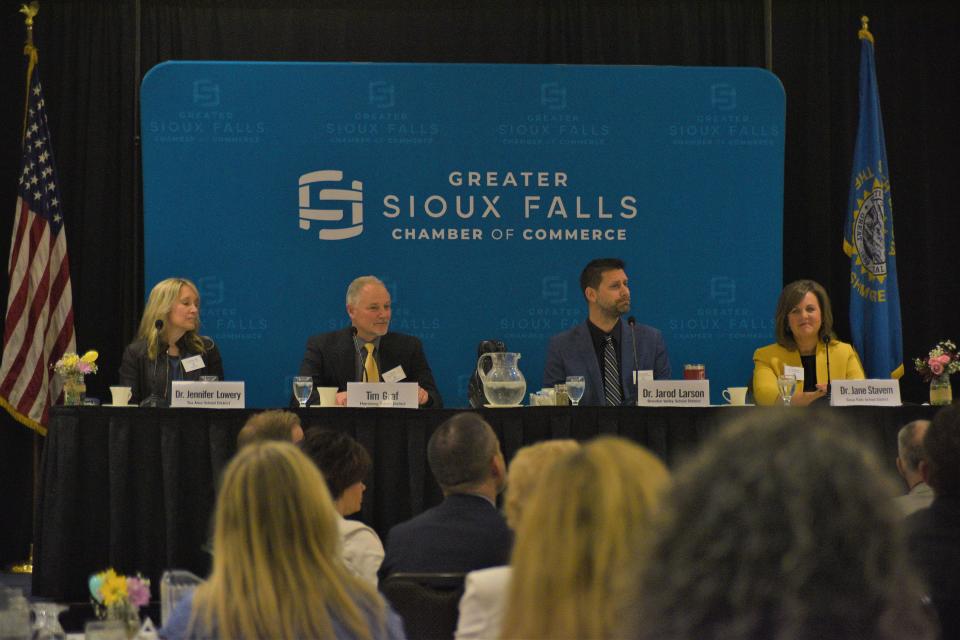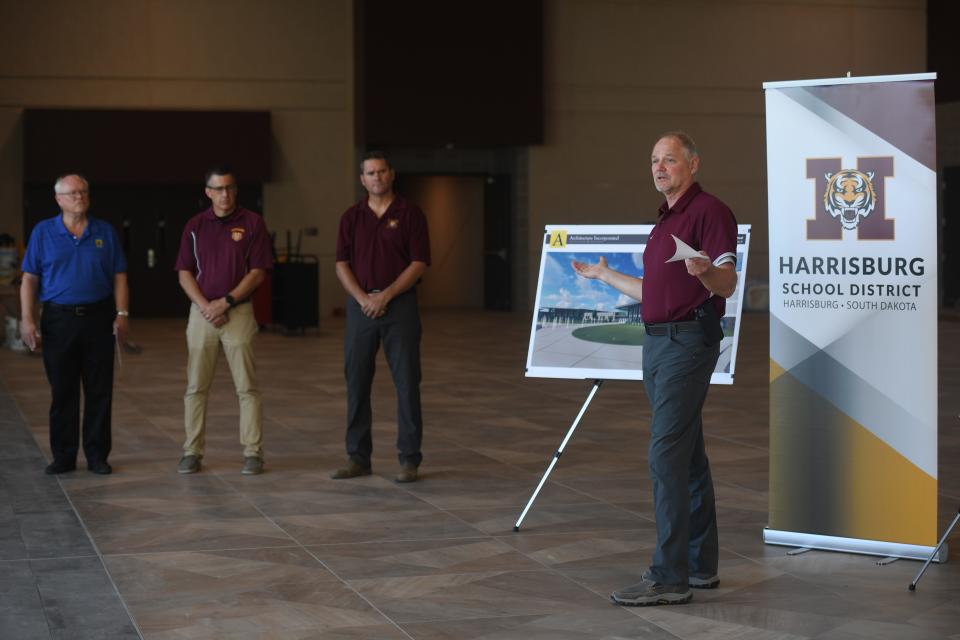Kristi Noem said South Dakota schools 'don't pass money along to teachers.' Districts disagree.
- Oops!Something went wrong.Please try again later.
Increases to the average teacher salary since fiscal year 2017 haven’t kept up with the increases in state aid to education.
In the years since the Blue Ribbon Task Force met in 2016 to pass a half-cent sales tax boost to increase what was then last-in-the-nation teacher salary, the statewide average teacher salary has risen 13% from $47,096 in FY17 when the change took effect, to $53,217 in FY23.
When state aid rose 12% that first year, the statewide average teacher salary rose by 11.7%. Teacher salary increases outpaced state aid increases in FY18 and FY19, but have been less than a percentage point behind in the four years since.
The disparity is something Gov. Kristi Noem called out in her budget address in December as she questioned, “Why should we continue to send money to school administrators and school boards when they do not pass it along to teachers?”
She proposed a 4% increase in state aid to education and encouraged it to go directly to teacher salaries.
More: Inflation, turnover, little aid: Why South Dakota’s landmark teacher pay law failed
In her State of the State address earlier this month, Noem said teachers would be the first priority and would be paid more, but did not propose exact solutions to raise teacher salaries.
Her stance on the issue has changed throughout her tenure as governor, but her office hasn’t answered questions about what caused her shift in position. Yet, school district leaders disagree with her stance and say they’ve been diligent about raising teacher salaries despite inflation and rising costs, as evidenced by data.
Are districts ‘not passing money along to teachers?’
Teacher salaries are determined by state aid, by local decisions made by district administration who propose the budget each year, and by school boards who approve the budget, which not only includes state, but federal and local funding streams, too.
“We cannot dictate to schools… how these dollars are spent, but I would encourage all of them to put as much of it into pay increases as they can,” Noem said in her 2022 budget address regarding state aid to education.
Noem’s tone changed in her December budget address as she advocated schools put the money from state aid directly into teacher salaries. Her office would not answer the Argus Leader's questions about why Noem changed her stance toward the issue. Teacher pay will certainly be a topic of conversation during the legislative session this year.
It’s inaccurate to say districts haven’t been sending state aid to teacher salaries, Tea Area School District Superintendent Jennifer Lowery said. The Tea Area school board and administration have been “incredibly diligent” in their responsibility to invest in teachers and staff, she explained.
The average teacher salary has risen 18% in Tea from $44,521 in FY17 to $52,537 in FY23.

Sen. Reynold Nesiba (D-Sioux Falls), a member of the Teacher Compensation Review Board, noted in September that it’s important to continue communicating that any increase to education funding doesn’t mean all of that funding goes toward increasing teacher pay, but to that and to other costs districts have.
What else do schools have to pay for with state aid?
As the demands to pay educators more money increases, so do the salary demands of other positions within the school, such as administrators, bus drivers, cooks, custodians and more.
A “tremendous portion” of state aid to school districts covers teacher salaries and benefits, but also has to cover positions like custodial, transportation and administrator salaries and benefits, which aren’t covered by separate special education or food service funding sources; electricity and water bills; diesel or propane buses; and, “operational non-capital pieces,” Lowery said.
For example, salaries for administrators increased more than teacher salaries did between the 2016-2017 school year and the 2021-2022 school year, according to data the DOE presented to the Teacher Compensation Review Board (TCRB) over the summer.
Teacher salaries increased by 7.84% during that time frame, while middle school principal salaries increased by 9.27%, elementary school principal salaries increased by 11.06%, high school principal salaries increased by 14.43% and superintendent salaries increased by 15.48%.
Educators asked the TCRB during the summer to consider looking into the overhead rate, capital outlay and general funds. Doug Wermedal, executive director of the Associated School Boards of South Dakota, said in August that demands into funding other areas of education can impact how teacher salaries are “realized.”
Sandra Waltman, director of government relations and communications at the South Dakota Education Association, also said in August that with the current overhead rate at 38.78%, for every $100 a school district has, there’s an expectation $61 to $62 of that should go toward teacher compensation, and the remainder go to “everything else."
More: Could another change in South Dakota's school funding formula be coming?
The reality is districts have to pay much more for a lot of the other positions than previously, Waltman said.
“If (the state) doesn’t address the overhead rate, it’s going to continue to drag down teacher salaries across the state,” Waltman said. “Target teacher salary and average teacher salary are starting to deviate. (South Dakota) is probably never going to have those two numbers match up, but our concern (is to) look at why those numbers are deviating.”
Board member and Aberdeen Superintendent Becky Guffin said in August that districts are paying for other parts of education in an “unprecedented manner,” including health insurance for employees, natural gas and pay for non-certified staff such as custodians, as the district competes with other industries in the city for those workers.
Have local districts increased teacher salaries since FY17?
Harrisburg School District Superintendent Tim Graf said his district has given the same percentage increase, or better, to teachers as it’s received from the state in the past few years. It’s also given a higher percentage to support staff than it’s received from the state, he said.
Harrisburg's average teacher salary has increased 25.1% from $44,343 in FY17 to $55,475 in FY23.
“With the opening of two new buildings, this creates some additional inefficiencies which makes passing along teacher increases more difficult and something that is not sustainable,” Graf said. “Each of the 148 school districts across the state have their own unique situations.”

Prioritizing teacher and staff compensation is crucial for “our laser-like focus on the creation of learning environments that result in success,” Brandon Valley School District superintendent Jarod Larson said.
While the statewide average teacher salary rose 13% from $47,096 in FY2017 to $53,217 in FY2023, here’s how those salaries rose in local school districts during the same time period, according to a report from the School Finance Accountability Board:
25.1% in Harrisburg, from $44,343 in FY17 to $55,475 in FY23.
21% in Lennox, from $42,698 in FY17 to $51,661 in FY23.
20.6% in Garretson, from $42,262 in FY17 to $50,947 in FY23.
20.3% in Brandon Valley, from $49,588 in FY17 to $59,661 in FY23.
18% in Tea, from $44,521 in FY17 to $52,537 in FY23.
14.5% in Baltic, from $45,406 in FY17 to $51,993 in FY23.
11.5% in Sioux Falls, from $51,063 in FY17 to $56,932 in FY23.
10.5% in West Central, from $47,969 in FY17 to $53,000 in FY23.
9.6% in Dell Rapids, from $44,796 in FY17 to $49,083 in FY23.
9.2% in Tri-Valley, from $47,008 in FY17 to $51,349 in FY23.
Statewide, the increases ranged from 35.7% in Elk Mountain ($37,456 to $50,811) to 2.5% in Rapid City ($51,335 to $52,621).
While Noem did not propose exact solutions to raise teacher salaries in her State of the State Address, she said in her budget address that she’s working with Graves to “bring some ideas to the Legislature about how to bridge this gap.”
That’s most likely along the lines of what the TCRB directed the DOE to do in its meetings over the summer: craft an updated teacher salary/compensation accountability model that enhances average teacher salaries at the district and state levels.
This article originally appeared on Sioux Falls Argus Leader: Where does state aid for education in South Dakota go?

